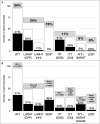Should Pediatric Endocrinologists Consider More Carefully When to Perform a Stimulation Test?
- PMID: 33828534
- PMCID: PMC8021019
- DOI: 10.3389/fendo.2021.660692
Should Pediatric Endocrinologists Consider More Carefully When to Perform a Stimulation Test?
Abstract
Introduction: Pediatric endocrinology rely greatly on hormone stimulation tests which demand time, money and effort. The knowledge of the pattern of pediatric endocrinology stimulation tests is therefore crucial to optimize resources and guide public health interventions. Aim of the study was to investigate the distribution of endocrine stimulation tests and the prevalence of pathological findings over a year and to explore whether single basal hormone concentrations could have saved unnecessary stimulation tests.
Methods: Retrospective study with data collection for pediatric endocrine stimulation tests performed in 2019 in a tertiary center.
Results: Overall, 278 tests were performed on 206 patients. The most performed test was arginine tolerance test (34%), followed by LHRH test (24%) and standard dose Synachthen test (19%), while the higher rate of pathological response was found in insulin tolerance test to detect growth hormone deficiency (81%), LHRH test to detect central precocious puberty (50%) and arginine tolerance test (41%). No cases of non-classical-congenital adrenal hyperplasia were diagnosed. While 29% of growth hormone deficient children who performed an insulin tolerance test had a pathological peak cortisol, none of them had central adrenal insufficiency confirmed at low dose Synacthen test. The use of basal hormone determinations could save up to 88% of standard dose Synachthen tests, 82% of arginine tolerance + GHRH test, 61% of LHRH test, 12% of tests for adrenal secretion.
Conclusion: The use of single basal hormone concentrations could spare up to half of the tests, saving from 32,000 to 79,000 euros in 1 year. Apart from basal cortisol level <108 nmol/L to detect adrenal insufficiency and IGF-1 <-1.5 SDS to detect growth hormone deficiency, all the other cut-off for basal hormone determinations were found valid in order to spare unnecessary stimulation tests.
Keywords: central adrenal insufficiency; central precocious puberty; congenital adrenal hyperplasia; endocrinologic diseases; epidemiology; growth hormone deficiency; stimulation tests; visit and budget of health.
Copyright © 2021 Penco, Bossini, Giangreco, Vidonis, Vittori, Grassi, Pellegrin, Faleschini, Barbi and Tornese.
Conflict of interest statement
The authors declare that the research was conducted in the absence of any commercial or financial relationships that could be construed as a potential conflict of interest.
Figures


Similar articles
-
AMERICAN ASSOCIATION OF CLINICAL ENDOCRINOLOGISTS AND AMERICAN COLLEGE OF ENDOCRINOLOGY GUIDELINES FOR MANAGEMENT OF GROWTH HORMONE DEFICIENCY IN ADULTS AND PATIENTS TRANSITIONING FROM PEDIATRIC TO ADULT CARE.Endocr Pract. 2019 Nov;25(11):1191-1232. doi: 10.4158/GL-2019-0405. Endocr Pract. 2019. PMID: 31760824
-
Long-acting intramuscular ACTH stimulation test for the diagnosis of secondary adrenal insufficiency in children.J Pediatr Endocrinol Metab. 2019 Jan 28;32(1):57-63. doi: 10.1515/jpem-2018-0330. J Pediatr Endocrinol Metab. 2019. PMID: 30530907
-
Evaluation of adrenal function in patients with growth hormone deficiency and hypothalamic-pituitary disorders: comparison between insulin-induced hypoglycemia, low-dose ACTH, standard ACTH and CRH stimulation tests.Eur J Endocrinol. 2005 May;152(5):735-41. doi: 10.1530/eje.1.01911. Eur J Endocrinol. 2005. PMID: 15879359
-
AMERICAN ASSOCIATION OF CLINICAL ENDOCRINOLOGISTS AND AMERICAN COLLEGE OF ENDOCRINOLOGY DISEASE STATE CLINICAL REVIEW: UPDATE ON GROWTH HORMONE STIMULATION TESTING AND PROPOSED REVISED CUT-POINT FOR THE GLUCAGON STIMULATION TEST IN THE DIAGNOSIS OF ADULT GROWTH HORMONE DEFICIENCY.Endocr Pract. 2016 Oct;22(10):1235-1244. doi: 10.4158/EP161407.DSCR. Epub 2016 Jul 13. Endocr Pract. 2016. PMID: 27409821 Review.
-
[Functional diagnostics in endocrinology].Internist (Berl). 2018 Jan;59(1):38-47. doi: 10.1007/s00108-017-0360-7. Internist (Berl). 2018. PMID: 29260252 Review. German.
Cited by
-
Clinical and laboratory characteristics but not response to treatment can distinguish children with definite growth hormone deficiency from short stature unresponsive to stimulation tests.Front Endocrinol (Lausanne). 2024 Mar 1;15:1288497. doi: 10.3389/fendo.2024.1288497. eCollection 2024. Front Endocrinol (Lausanne). 2024. PMID: 38495788 Free PMC article.
-
Minimizing unnecessary brain magnetic resonance imaging in pediatric endocrinology: a retrospective cohort analysis.Front Endocrinol (Lausanne). 2024 Sep 3;15:1456541. doi: 10.3389/fendo.2024.1456541. eCollection 2024. Front Endocrinol (Lausanne). 2024. PMID: 39290328 Free PMC article.
-
Prevalence and characteristics of thelarche variant.Front Endocrinol (Lausanne). 2023 Dec 1;14:1303989. doi: 10.3389/fendo.2023.1303989. eCollection 2023. Front Endocrinol (Lausanne). 2023. PMID: 38107513 Free PMC article.
-
Reduction in pediatric growth hormone deficiency and increase in central precocious puberty diagnoses during COVID 19 pandemics.Ital J Pediatr. 2022 Mar 28;48(1):49. doi: 10.1186/s13052-022-01238-1. Ital J Pediatr. 2022. PMID: 35346309 Free PMC article.
-
A Short-Duration Gonadotropin-Releasing Hormone Stimulation Test for the Diagnosis of Central Precocious Puberty.Medicina (Kaunas). 2023 Dec 22;60(1):24. doi: 10.3390/medicina60010024. Medicina (Kaunas). 2023. PMID: 38256285 Free PMC article.
References
-
- Brook CGD, Claytor PW, Brown RS. Brook"s Clinical Pediatric Endocrinology. 6th edition. Chichester, UK Hoboken: Wiley-Backwell; (2009).
-
- Maguire AM, Biesheuvel CJ, Ambler GR, Moore B, McLean M, Cowell CT. Evaluation of adrenal function using the human corticotrophin-releasing hormone test, low dose Synacthen test and 9am cortisol level in children and adolescents with central adrenal insufficiency. Clin Endocrinol (Oxf) (2008) 68:683–91. 10.1111/j.1365-2265.2007.03100.x - DOI - PubMed
MeSH terms
Substances
LinkOut - more resources
Full Text Sources
Other Literature Sources
Medical
Miscellaneous

